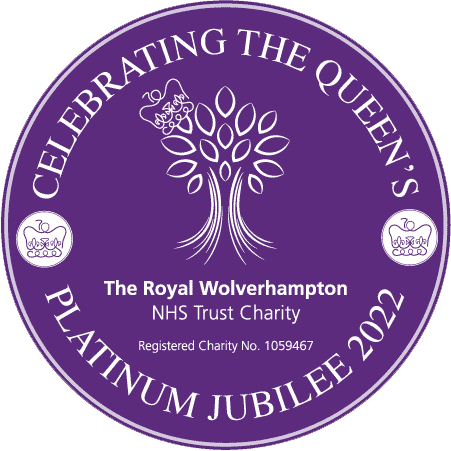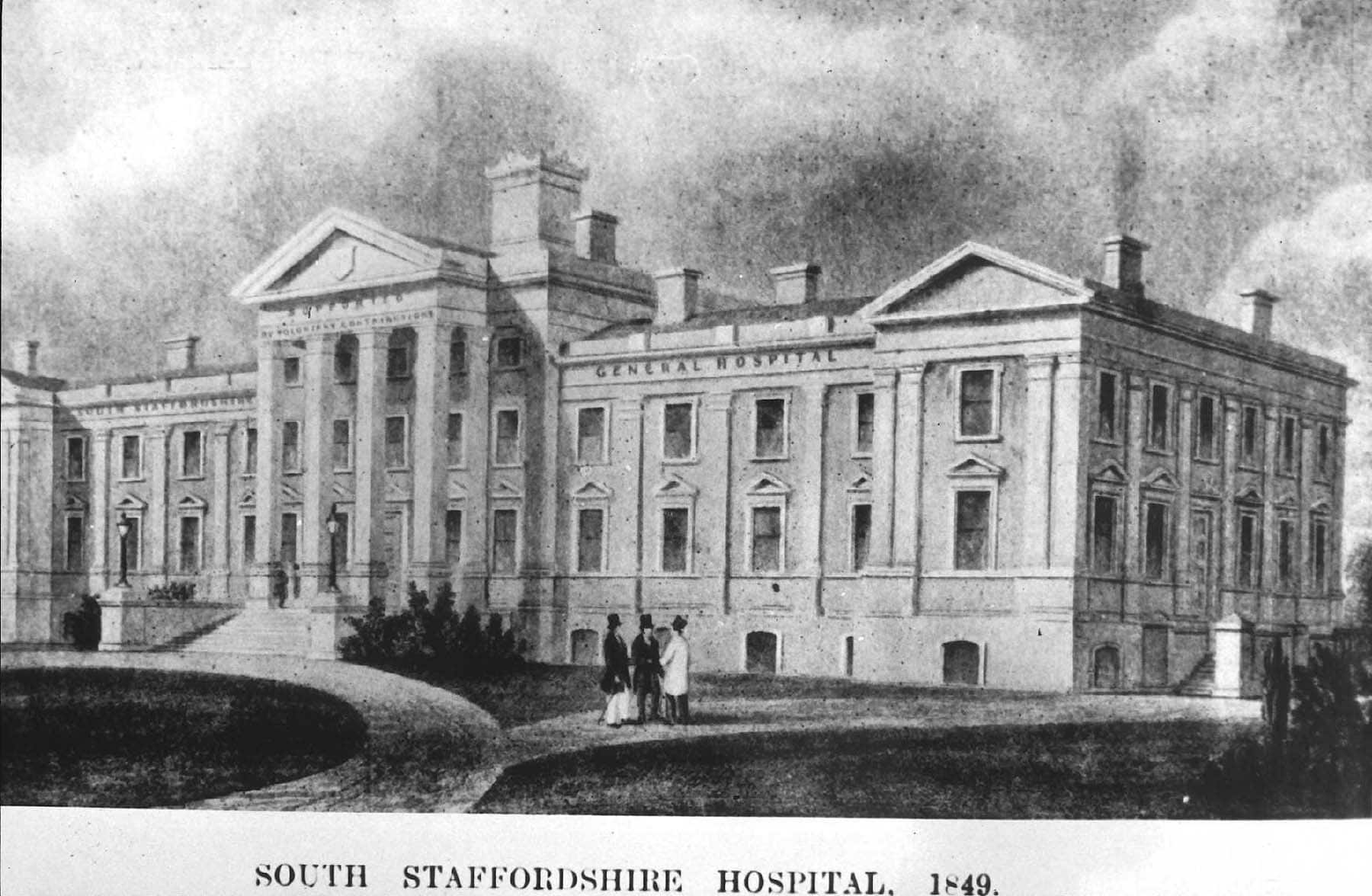In June 2022, Her Majesty The Queen became the first British Monarch to celebrate a Platinum Jubilee, after an incredible 70 years of service.

The Royal Wolverhampton NHS Trust is proud of its heritage and its connection to the Royal family following the historic build of The Royal Hospital. The build was only possible thanks to charitable donations from Victorian businessmen in Wolverhampton that determined that the town was worthy of a hospital as a replacement to a six-bedded Dispensary. A total of £18,000 was raised which bought land from the Duke of Cleveland and a hospital with 84 beds was built.
The hospital opened its doors on the 1 January 1849 to ‘patients who are such unable to pay for medicine and advice and are destitute of funds to make provision for them’. It was run by self-supporting Board of Governors and was totally dependent for its complete running costs one original staff consisted of a Matron, one Physician, one Consulting Surgeon, three Surgeons, one House Surgeon and a secretary. The House Surgeon, Edward Hayling Coleman, had, in 1847, carried out the third-ever operation using anaesthesia, in England. During the first year of operation, 408 inpatients and 2,853 outpatients were treated at the hospital.
A children’s ward was established in 1862, overturning a rule which had excluded the treatment of children under six years old in hospital. A new wing for inpatients and a new outpatient block were added in 1872 to reduce overcrowding.

In 1873 official recognition from the Royal College of Surgeons, gave the Royal Hospital approval as a teaching hospital.
As the hospital moved into the 20th century many modern facilities were introduced. Electricity replaced gas lighting and, in 1900, the operating theatre was lit by electricity.
In 1875 an organisation was founded in Parkdale by a Mrs. E.A. Whitehouse with a sum of £50 for the Outdoor Blind. Resulting from these factors, a meeting was held under the supports of the Briscoe family, Edward Banks retired architect and Dr. W. Millington to raise charitable donations to establish an Eye Infirmary to ease the significant pressure faced by the Cleveland Road Hospital for conditions such as Ophthalmia Neonatorum (which was increasingly becoming widespread due to social conditions of the day). Initially, only 10 beds were provided and there was an average daily queue of 50 people waiting outside for treatments, all patients were treated irrespective of their ability to pay or provision of a subscriber ticket from employer, Minister of Religion or benefactor to the services.

New Cross began its life on the 60-acre site in Wednesfield Road as a large public workhouse in 1904. Following the 1st World War and the general economy of the country improving, central government ordered that workhouses were to be converted to public hospitals funded by the local authority and free to general use.
By the year 1912, The Royal Hospital had developed a 53-bed nurses’ home, a new wing of beds dedicated to King Edward VII, its own motorised ambulance provided by Wolverhampton Police Force, an electric lift and a new laboratory. In the ten years immediately after the war, the hospital added many new departments and wards including operating theatres and VD clinics.
On June 13th, 1923 HRH The Prince of Wales visited the hospital to present its Royal Charter of Incorporation, establishing the hospital as a legally constituted body. That same year saw the General Nursing Council approve the hospital for nurse training. Five years later, on the 28th of December 1928, HM King George V declared that from there on the Wolverhampton and Staffordshire General Hospital should be known as The Royal Wolverhampton Hospital.

New Cross opened its doors in 1929, run by Wolverhampton Council with free provision of care and a coat of arms was granted in July 1930.
With the ending of the Second World War many ex-servicemen returning home, who had served with the Medical Services i.e. Royal Navy, Royal Army Medical Corps and R.A.F., sought to continue their careers at The Royal. Miss G.G. Goodchild, Matron at The Royal Hospital, and sister of the Chief Constable Norman Goodchild had determined that these ‘rough men’ were not going to work alongside her staff, but, considering the extra demands being placed on the hospital and shortage of female staff, the employment of men looked favourable. Mr. C.O. Langley, Wolverhampton Coroner and Chairman of the governing body of the hospital, called an emergency meeting of the governors, after which Matron Goodchild was invited to consider her position in the light of her inability to employ male nurses. The next day she departed Wolverhampton, after being the shortest serving Matron in the history of the hospital.
Assistant Matron Miss M.K. Gray immediately took up the post and quickly established a Male Nurse Training School and additional posts for men in the new Physiotherapy and Radiography training schools, and within six months a total of thirty-one male nurses and orderlies were employed at the hospital mostly drawn from ex-servicemen. It was to be until the late 60s that male nurses were accepted for membership of The Royal College of Nursing, and initially they sought support in The Society of Registered Male Nurses, whose membership was so strong in the West Midlands that their annual congress was held in Wolverhampton in 1959.
The 1950s saw the Eye Infirmary become the 4th largest workload eye centre in the UK and it was now becoming evident from the Commonwealth that many of their eye service provision was being provided by a doctor formerly trained in Chapel Ash, 1958 saw the first International Ophthalmic Nurses Conference held.
With the development of the NHS in 1948 there was larger and wider provision of medical care.
The first separate facilities for the treatment of women’s diseases or obstetrics did not come until the establishment of the Women’s Dispensary in 1886 which changed its name to the Wolverhampton and District Hospital for Women in 1889. The object of the hospital was to treat women “afflicted with diseases peculiar to their sex” and it consisted of in-patient and out-patient departments. The hospital was financed by voluntary donations and was initially in a house in St Mark’s Place until it moved to new purpose-built accommodation at Park Road West in 1904.
In 1926 there was a proposed merger with the Maternity Home at the District Nursing Association (but not the nursing association). The merger did not take place because the Hospital for Women strongly held on to the principles of voluntary hospitals whereas the Maternity Home seemed to have been a fee-based institution. Both the Hospital for Women and District Nursing Association and Maternity Home combined with the Royal Hospital, Wolverhampton in 1928.
In 1975 gynaecological services were transferred to New Cross and the hospital was renamed West Park Hospital housing mainly ‘geriatric’ patients. The building was finally demolished in 1978 and new accommodation was built for the West Park Hospital.

The new maternity unit was opened by Princess Anne in May 1971, finally encompassing gynaecology within a 2–3year period hence providing total care including a neo-natal unit just like its predecessor at West Park. The Tettenhall Road ‘Beeches’ and Bath Road unit were no more and subsequently the West Park site came under Primary Care control with considerable new building and renovation plus provisions of care for a wide age group of conditions and patients took place. The hospital was largely demolished in 1978 to make way for West Park Hospital.
In the 1980’s many of the specialities from The Royal moved away to New Cross Hospital and over the next decade the wards closed. A full transfer of all departments was seen including Cancer Care, E.N.T, Paediatric and A&E Departments. But as the 148th anniversary of the hospital approached it was closed in 1997.
Special thanks to Roy Stallard for sharing his wealth of knowledge of The Royal Hospital.


